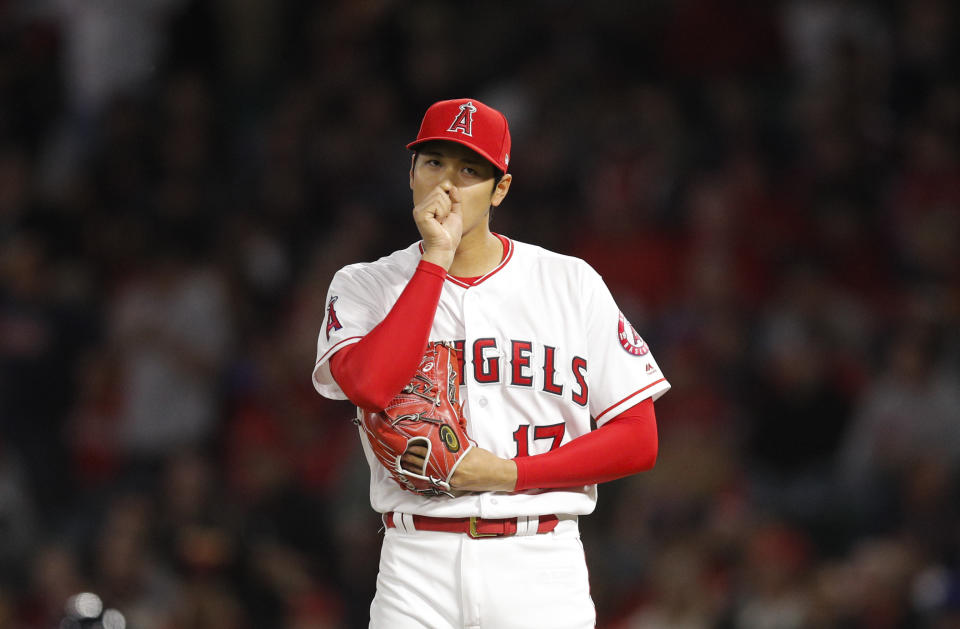Shohei Ohtani reminded that it's not that easy after rough start vs. Red Sox
ANAHEIM, Calif. – This here, Tuesday night in a full ballpark expecting something like magic, the schedule not exactly perfect, the opponent not exactly the Oakland A’s, is what happens instead sometimes. This here is a 23-year-old pitching nine days later, against a bunch of grown and decorated men, on a night when not a single pitch will behave, when it seems like it won’t ever end. And it’s the second inning.
This is the part where it begins to look a little different. That reminds everyone it’s not that easy, that it never is, that 100-mph fastballs carry a long way the other direction too, that 90-mph splitters aren’t so devious when they barely clear the grass, that all the homemade signs and new T-shirts and parking revenues count little toward pitching precision.
Los Angeles Angels rookie Shohei Ohtani, the two-way phenomenon from Japan whose 2 ½-week toe-dip into the big leagues had wrought a 2-0 record and a 2.08 ERA (along with a .367 batting average and three home runs), in his third start gave up three runs in two innings, threw a gluttonous 66 pitches, forced but three swings-and-misses among them, and in the end left because (at least in part) of a blister on the middle finger of his throwing hand.
This was a young man who, due to a six-man rotation and a weather postponement, hadn’t thrown a competitive pitch since two Sundays ago. Also a young man who looked as though he’d given a little too much thought to his first big test, that being the Boston Red Sox of Mookie Betts, Hanley Ramirez, J.D. Martinez, et al. And, therefore, a young man who spiked his first few splitters, all but stumbled while throwing his first curveball, spun a good portion of his sliders waist-high, and so was left with a reliably big fastball but with none of the trimmings.

Also, perhaps, a developing blister, which Ohtani apparently has been prone to, the sort of thing 38 pitches in a single inning (the second) would seem to inflame.
The final line over two innings said something about four hits and two walks and three runs, one of them on Betts’ home run seven pitches in, those nine days after he was all but unhittable against the A’s. This time, the fastballs that had grazed the perimeter of the strike zone, the splitters that for the better part of 60 feet had looked so much like strikes, the sliders that had skittered away from the bat barrels, well, there was very little grazing or looking like or skittering away. There was a lot of blowing on his hand on a warm night, of awaiting catcher Martin Maldonado’s return throw, of searching for a repeatable release point.
After two innings, and with the bullpen already warmed behind him, Ohtani pushed his cap back on his head, hiked up his pants, and walked out from under the eyes of nearly 45,000 people — the Angels’ largest crowd of the season — to see him and the challenge that was the Red Sox. The Red Sox won, 10-1. Betts hit three home runs. Those remaining by the third of the home runs were generally Red Sox fans, and so the big roll out of the 13-3 Angels and their prized new ace against the 13-2 Red Sox and David Price ended with a thud, some unwanted puss and a lot of conversation about the two-way guy’s middle finger.
This here, then, is what a baseball season looks like, one little issue after another, great promise followed by whatever-the-heck-that-was followed by another game tomorrow, and a chance to start all over. On the schedule established over 16 prior games, Ohtani would take Wednesday night’s game to recover, then return Thursday night as the designated hitter. He seemed largely unconcerned with the blister, even saying he could have pitched through the ailment and resulting imprecision were the season at a more critical juncture. Manager Mike Scioscia said he expected Ohtani would be healthy enough to make his next start – presumably next Tuesday in Houston – but there’d be no reason to rush to a decision. Ohtani and Scioscia seemed optimistic the blister would not hinder Ohtani’s hitting.
Three-and-a-half hours after the public address announcer had blasted, “The starting pitcher, No. 17, Sho-HEYYY Oh-TA-nee!” and the crowd had roared, and the first fastball had buzzed home in the mid-90s, and everyone had settled in for another good look at the young man who will help to turn a franchise, there was only the blister. And what happened. And why. And what now.
“The blister actually developed in my last start,” Ohtani explained. “I felt like it would be fine. … The high intensity of this game, it didn’t hold up too well.”
While the resulting lack of command seemed most obvious on his splitter, Ohtani said, “My fastball, I didn’t have good feel off my fingertips.”
Maybe it’s more of the new baseball, whose stitches are said to run higher in the American game. Maybe it’s the wear and tear of the splitter, as Ohtani fought blisters in Japan, as well. And, probably, it’s nothing more than the rigors of the early days of a new career, in the early days of a new season, and therefore expecting that sometimes it’ll all rub a bit thin. Maybe on the fingers. Maybe on the scoreboard.
“Another lesson,” Ohtani said. “Something I have to learn. … Something I need to get better at for the next time.”
More from Yahoo Sports:
• Teammate bursts into tears during NFL star’s retirement
• Charles Robinson: Why things may get ugly for Rodgers, Packers
• Report: LeBron sued over barbershop web show
• Are Yankees fans being too tough on Stanton?



